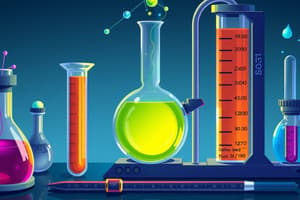Podcast
Questions and Answers
How do you find the difference/required amount of liquid to go from one volume to another?
How do you find the difference/required amount of liquid to go from one volume to another?
found by subtraction
What should you do to stabilize the buret setup?
What should you do to stabilize the buret setup?
Move the buret clamp to a ring stand with a larger base
What practice will not help you make an accurate volume reading on a buret at the beginning of a titration?
What practice will not help you make an accurate volume reading on a buret at the beginning of a titration?
Make sure that the meniscus starts exactly at 0.00 mL
How should you read graduated cylinder measurements?
How should you read graduated cylinder measurements?
Where should the bumper be on the graduated cylinder?
Where should the bumper be on the graduated cylinder?
From what level should you read the graduated cylinder?
From what level should you read the graduated cylinder?
What kind of glassware is designed to measure one specific volume of liquid?
What kind of glassware is designed to measure one specific volume of liquid?
What type of glassware is capable of measuring a range of volumes of liquid?
What type of glassware is capable of measuring a range of volumes of liquid?
What type of glassware is used for applications in which great accuracy is needed?
What type of glassware is used for applications in which great accuracy is needed?
When should the tare button on a balance be used?
When should the tare button on a balance be used?
When using the Tare function on a balance, start by ______ Then _______ to cancel out the mass. Finally, ______ and record the mass of your sample.
When using the Tare function on a balance, start by ______ Then _______ to cancel out the mass. Finally, ______ and record the mass of your sample.
What are the best practices while sharing a lab balance with other students?
What are the best practices while sharing a lab balance with other students?
What is the % error formula?
What is the % error formula?
What is the error of a measurement?
What is the error of a measurement?
What is the density formula?
What is the density formula?
How should your significant figures match up?
How should your significant figures match up?
What is a beaker used for?
What is a beaker used for?
What is an Erlenmeyer flask used for?
What is an Erlenmeyer flask used for?
What are funnels used for?
What are funnels used for?
What are graduated cylinders used for?
What are graduated cylinders used for?
On a graduated cylinder, how do volume measurements increase?
On a graduated cylinder, how do volume measurements increase?
Flashcards are hidden until you start studying
Study Notes
Measurement Techniques
- Required volume difference calculated through subtraction.
- Accurate volume readings on a buret are hindered if the meniscus is set at exactly 0.00 mL at the beginning of a titration.
Buret Stability
- For stability, move the buret clamp to a ring stand with a larger base.
Glassware Types
- Volumetric glassware measures a specific volume of liquid precisely.
- Graduated glassware can measure a range of volumes, suitable for instances where accuracy is necessary.
Proper Use of Graduated Cylinders
- Always read measurements from the bottom of the meniscus at eye level.
- The bumper should be positioned at the top of the graduated cylinder to prevent breakage from falls.
Balance Functionality
- Use the tare button on a balance to eliminate the weight of glassware from measurements.
- To use the tare function: place glassware on the balance, press the tare button, then add the sample and record the mass.
Best Practices in the Lab
- When sharing balances, inform the teaching assistant about any issues and clean chemical dust from the balance after use.
Error and Density Calculations
- Percentage error is calculated by: [(\text{error}/ \text{accepted value}) \times 100].
- Error in measurement is determined as: [((\text{Experimental value} - \text{Accepted value}) / \text{Accepted value}) \times 100].
- Density is calculated using the formula: mass/volume.
Significant Figures
- Keep significant figures consistent: if the original number has three significant figures, your answer should also have three.
Laboratory Glassware Uses
- Beakers serve as temporary containers and for rough volume measurements.
- Erlenmeyer flasks are designed for mixing solutions.
- Funnels are utilized for filtration and transferring liquids, specifically with filter paper during filtering.
- Graduated cylinders are specifically used for measuring volumes of liquids.
Measurement Trends on Graduated Cylinders
- Volume measurements on graduated cylinders increase from the bottom (smallest) to the top (largest).
Studying That Suits You
Use AI to generate personalized quizzes and flashcards to suit your learning preferences.




